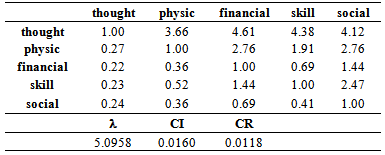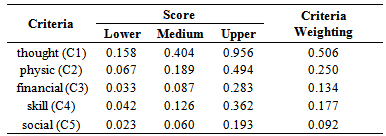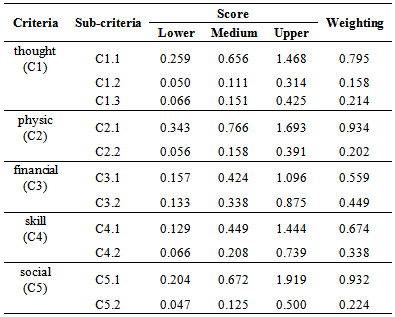-
Paper Information
- Previous Paper
- Paper Submission
-
Journal Information
- About This Journal
- Editorial Board
- Current Issue
- Archive
- Author Guidelines
- Contact Us
American Journal of Sociological Research
p-ISSN: 2166-5443 e-ISSN: 2166-5451
2014; 4(2): 53-59
doi:10.5923/j.sociology.20140402.05
Community Participation-based Spatial Strategy in Southern Cross Road Area of East Java, Malang
Gentur Prihantono1, 2, Sudarto1, 3, Keppi Sukesi1, 4, Mohammad Bisri1, 5
1Environmental Science and Technology Graduate Program, University of Brawijaya, Indonesia
2Department of Human Settlement, East Java Province, Indonesia
3Department of Soil, Faculty of Agriculture, University of Brawijaya, Indonesia
4Department of Social Economics of Agriculture, Faculty of Agriculture, University of Brawijaya, Indonesia
5Department of Water Resource Engineering, Faculty of Engineering, University of Brawijaya, Indonesia
Correspondence to: Gentur Prihantono, Environmental Science and Technology Graduate Program, University of Brawijaya, Indonesia.
| Email: |  |
Copyright © 2014 Scientific & Academic Publishing. All Rights Reserved.
The purpose of this study is to construct spatial planning strategy with community participation-based in the Southern Cross Road in Malang, East Java. Previous studies rarely distinguished the community participation into thought, physical, skills, financial and social. This research is a quantitative study that used Analytical Hierarchies Process (AHP). AHP is used to generate strategic recommendations in the development and enhancement of community participation in the South Cross Road area of East Java, especially in Malang (Subdistrict of Sumbermanjing Wetan, Bantur, Donomulyo and Gedangan). The results showed that community participation in development of Southern Cross Road in Malang district sequentially (from the highest to the lowest) is the participation of thought, physical, skills, financial and social.
Keywords: Southern cross road, Thought participation, Physical participation, Skills participation, Financial participation, Social participation
Cite this paper: Gentur Prihantono, Sudarto, Keppi Sukesi, Mohammad Bisri, Community Participation-based Spatial Strategy in Southern Cross Road Area of East Java, Malang, American Journal of Sociological Research, Vol. 4 No. 2, 2014, pp. 53-59. doi: 10.5923/j.sociology.20140402.05.
Article Outline
1. Introduction
- Process of development between economic and environmental activities interact and determine for each other. Economic activities required increasing economic growth to fulfill human needs. Economic development is a consequence of more increasing number of human population and living standards. Malthusian theory explained that economic growth is unsustainable due to environmental restrictions. Increasing in economic growth is increasing on natural resources exploitation from time to time. Available natural resources are depleted and ultimately destroy the economic system [4].Development paradigm has gradually shifted into efforts to increase community participation in various phases of development activities. Implementation principle of the program is to put the public as objects and subjects of development. Public is agents of development that is expected to continue/ develop the program and can solve their own problems, especially in improving the quality of development. It is closely related with the change and the implementation of spatial development, which imply that spatial development directly related to community participation [5].Public participation in a democratic system of government calls for public participation in the decision-making process which increasingly important in the era of regional autonomy. The implementation of regional autonomy under the Act of Republic of Indonesia Number 32/2004 on Regional Government has brought major changes in every segment of the organization of Local Government [6].From the late 1970s, the concept of community participation widely applied in the implementation of development projects. Emphasis on the community participation promoted after the development theory criticized the top-down implementation of community development programs. It claims that it was ineffective against poverty [7]. In the 1970s, development policy began to focus on the development of a new paradigm that centered on basic human needs. In this context, the theory of development (and government) recognizes the essential of community participation in the more efficient planning process, which led to more functional development projects. Cooke and Kothari [8] explained that the ineffectiveness of external form were imposed and expert-oriented research. The planning is becoming increasingly clear in the 1980s, when major donors and organizations development begin to adopt the methods of participatory research and planning.The main argument in favor of community participation is to put beneficiaries in the project development by encouraging their active participation in both the planning process and resources control that provided by the project. This argument is affected by fund aid agencies like the World Bank, which adopt the idea of community participation in initiatives development and projects [9-12]. Narrow meaning of development initiative means the mobilization of special programs beneficiaries. Beneficiaries, which is identified as the community, must be involved and emphasized in the decision making process of project implementation [13, 14, 15].Community participation in the process of development planning, policy planning, monitoring and the applicability of policies, is something that drives the success of an effective and efficient development. Problem that needs to be solved is to encourage people to participate in the development process itself. Encouraging does not oblige the community participation as well as encouraging people to sacrifice, but requires their own initiatives. Development is conducted for society then it is an absolute obligation for community to participate in it. Development experience proves that the development is often not in accordance with community expectations. In this case, the encountered obstacles or field encountered – in an attempt to implement a participatory development process – is not understood yet of the true meaning of the participation concept by the planners and the developer. SCR and spatial development in the region is not separated from the participation of the local community. Activities and community participation can be one of the major factors in the regional development of SCR’s spatial.Economic, geographic and development conditions of SCR closely related to the possibility of changes in the spatial area of the south coast of East Java. After SCR connecting East Java, Central Java, Yogyakarta and West Java, then it is possible to accelerate the development of the southern East Java. But not less important is the community participation in its implementation. It will certainly change the spatial structure surround the SCR. Therefore, we aimed to construct spatial planning strategy based on community participation in the Southern Cross Road in Malang, East Java.
2. Materials and Methods
- We used a quantitative approach by Analytical Hierarchies Process (AHP). The primary data obtained from the respondents in the SCR area by questionnaires and secondary data obtained from the agencies or institutions associated with this study, and also from government offices at the study site.
2.1. Study Area
- This research was conducted in the Southern Ring Road of East Java, Malang Regency (Sumbermanjing Wetan, Bantur, Donomulyo and Gedangan). Basis of these considerations on the four districts is the stages development of SCR that have reached 80% [2]. Neighborhood residential area on the Southern Cross Road generally has linear pattern along the main line and connecting lines. Some others form groups of settlements which spread and separated by agricultural land which generally dominate the use of land in each village, where the settlement in the residential area built by the community itself.Three types of settlements that built by the community itself are evolve settlements, well laid out settlements, and fisherman settlement. These three types of settlements have different characteristics. Evolved settlements dominate all villages in four passed-districts of the south traffic lane.
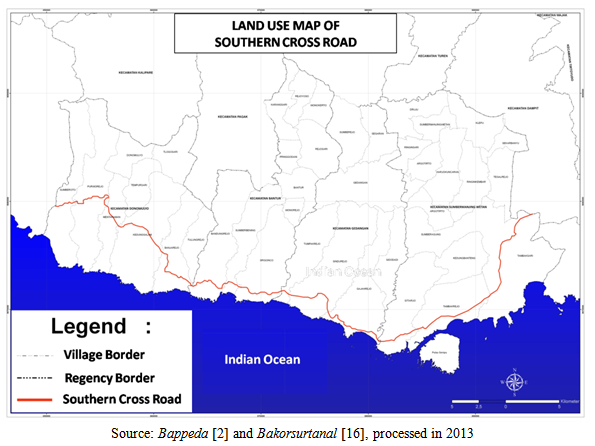 | Figure 1. Study area of Southern Cross Road (Sumbermanjing Wetan – Bantur – Donomulyo – Gedangan) |
2.2. Data Collection
- The data for the AHP analysis used input from the key persons, i.e. community leaders, community groups, academia and local government. The key persons are considered to contribute in the formulation of policy recommendations and practically competence. Competent key persons intended to reliable input for producing optimum recommendations [17]. There are four assessed elements of stakeholders. (1) Government, represented by BAPPEDA as program coordination institutions and regional development planning; (2) Legislative, represented by the member of DPRD (Parliament) of Malang Regency; (3) University, involved experts from University of Brawijaya on the planning development; (4) Community of Bantur, Donomulyo, Gedangan and Sumbermanjing, represent the districts of Malang.
2.3. Data Analysis
- AHP measurement done by constructing a measurement scale in the form of index, scoring, or a certain numerical value. We used some principles in resolving problems with AHP, i.e. decomposition, comparative, judgement, priority synthetic and consistency logic [17]. Stages of AHP approach include: (1) system identifying, i.e. identify the problem and determine the desired solution; (2) develop hierarchical structure that begins with general purpose, and sub-purpose criteria and possible alternatives criteria; (3) compose a pairwise comparison matrix that describes the relative influence or the influence of each element on each purpose level. The comparison is based on the judgement of decision-makers, by assessing the importance degree of the elements; (4) calculate the matrix of individuals opinion; (5) calculate the value of combined opinion; (6) horizontal processing; (7) vertical processing; and (8) revise opinions. The details of hierarchical structure in the policy formulation of strategic referral describe in Fig. 2.
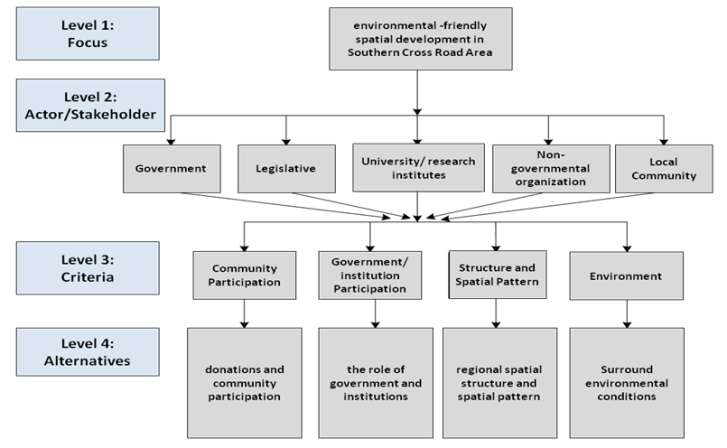 | Figure 2. Hierarchy structure of Referral Formulation of Policy Strategy [17] |
3. Results and Discussion
- Community participation is divided into five criteria: participation of thought, physical, financial, skills, and social that involved a total of 11 sub-criteria which processed further on the consistency and priorities test to construct the spatial planning strategy with community-based participation in Southern Cross Road of East Java (Fig. 3).
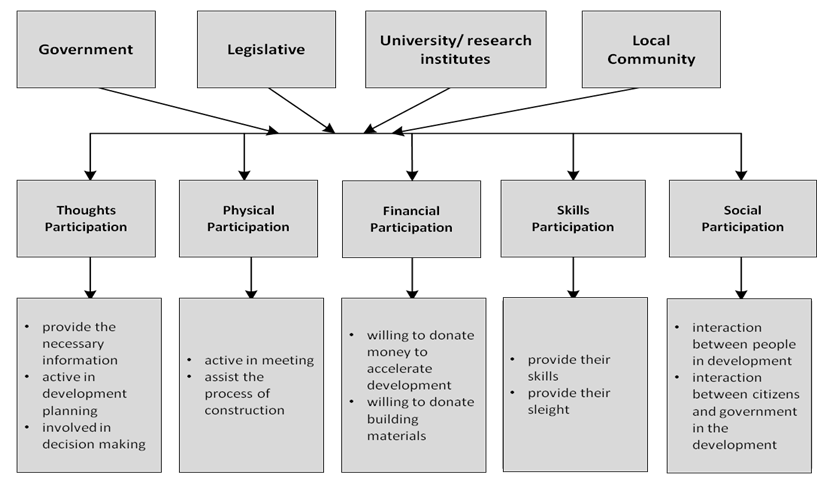 | Figure 3. AHP Results on Spatial Community - based Participation of Southern Cross Road of East Java in Malang |
3.1. Consistency Assessment
- Hierarchy in this study consisted of five criteria. Therefore, formed pairwise comparison matrix is 5 x 5 orders (Table 1). The matrix of pairwise comparisons between criteria has a value of CR = 0.0118 or 1,18%. Because the value of CR < 5%, then the pairwise comparison matrix is expressed as consisten. Table 2 presented the value of consistency for the sub-criteria. The matrix of pairwise comparisons between sub-criteria has a value of CR < 5% or CR > 0.05, then the pairwise comparison matrix is expressed as consistent. Thus, appropriate field data obtained for the AHP analysis.
|
|
3.2. Priority Assessment
- The results of the first phase analysis obtain five criteria, i.e. participation of thought (C1), physical (C2), financial (C3), skills (C4), and social (C5). Results showed the weighting priority of each criterion in Table 3 and each sub criterion in Table 4.
|
|
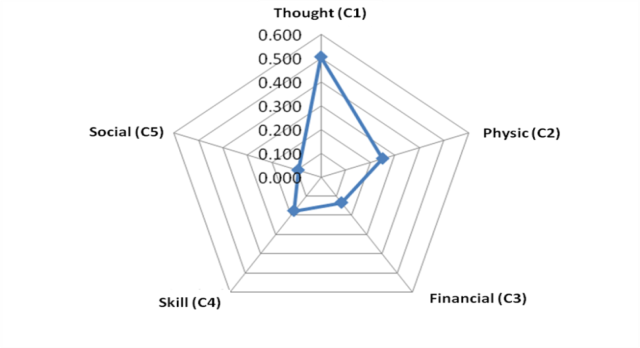 | Figure 4. Public Participation in SCR Development |
4. Conclusions
- Public participation in SCR development of Malang Regency includes participation of thought, physic, skills, financial and social. Participation of thought implied in providing the necessary information, active in development planning, and involved in decision making. Physical participation includes active in a meeting, and contribute to the completion of development. Skills participation means provides the possessed skills. Financial participation includes voluntary money and building materials donation to facilitate the development. Social participation is interaction between people in the development process, as well as the interaction between citizens and government.All those participation would support our suggestion as follows. The process of spatial management and plan information should be done through the printed and electronic media on forums and meeting to apply the principle of transparency in every aspect and stage of the planning to create trust between government and community. The nature of community participation is no longer on the initiative of the government but increased more by the initiative of community themselves. Period to provide feedback/ suggestion/proposal/consideration should be sufficient to accommodate the holistic public and stakeholder input into efforts to gain support and commitment. We also suggest more in-depth follow-up study on the contribution of public participation in the spatial arrangement of SCR of East Java, which accommodated into spatial planning products.
ACKNOWLEDGEMENTS
- The author would like to thank the Governor of East Java, the Government of Malang Regency, Rector of Brawijaya University, Director of Graduate Program of Brawijaya University, Department Human Settlement of East Java Province, the District of Sumbermanjing Wetan, Bantur, Donomulyo and Gedangan.
 Abstract
Abstract Reference
Reference Full-Text PDF
Full-Text PDF Full-text HTML
Full-text HTML